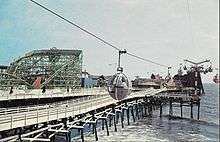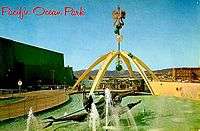Pacific Ocean Park
|
Vintage postcard circa 1959 showing the entrance plaza of Pacific Ocean Park | |
| Location | Santa Monica, California, USA |
|---|---|
| Opened | 26 July 1958 |
| Closed | 6 October 1967 |
Pacific Ocean Park was a twenty-eight acre (110,000 m²), nautical-themed amusement park built on a pier at Pier Avenue in the Ocean Park section of Santa Monica, California, which was intended to compete with Disneyland.[1][2] "And Disneyland and POP is worth a trip to L.A." is a line from the Beach Boys' song "Amusement Parks U.S.A." from their 1965 album Summer Days (And Summer Nights!!). After it closed and fell into disrepair, the park and pier anchored the Dogtown area of Santa Monica.
The Beginning

"POP" (pronounced "pee-oh-pee"), as it was soon nicknamed, was a joint venture between CBS and Santa Anita Park.[3] It opened on Saturday, July 28, 1958 with an attendance of 20,000. The next day, the park drew 37,262 which outperformed Disneyland's attendance that day.[4] Admission was ninety cents for adults which included access to the park and certain exhibits. The term "POP" was also used as a clever acronym for "Pay One Price", though other rides and attractions were on a pay-as-you-go basis.
Like Disneyland, Pacific Ocean Park found corporate sponsors to share the expense of some exhibits.[5] Six of the pier's original attractions were incorporated into the new park: The Sea Serpent roller coaster, the antique Looff carousel, the Toonerville Fun House, the Glass House, twin diving bells and more.
Attractions
Among a standard complement of carnival-style attractions and rides were the following:
- Westinghouse Enchanted Forest/USS Nautilus Submarine Exhibit featured a 150-foot (46 m)-long model of the atomic reactor section of a submarine.
- House of Tomorrow was themed like similar "looks at the future" featured at Disneyland and the World's Fair. Elektro, the talking and smoking robot from the 1939 World's Fair, was a prominent display.
- Sea Circus was included in the basic attraction price. Performing dolphins and sea lions played to audiences of 2000 at a time. After the show, visitors could feed seals in the Seal Pool.

- Diving Bells in which passengers were submerged into a large tank via hydraulic pistons. An underwater view of the tank was visible through the portholes. The ride was manufactured by Martine and this was their dual Maritime Diving Bells. Another such ride also existed in single fashion at the Long Beach Nupike and also Coney Island Astroland. The thrill of the ride occurred when the bell was allowed to "surface". When the hydraulic pressure holding the bell down was released the bell would shoot back up to the surface in dramatic fashion.

- Ocean Skyway built by Von Roll were bubble-shaped gondolas suspended 75 feet (23 m) above the surface of the ocean. Passengers were treated to a one-half mile (800 m) trip out to sea and back.
- Union 76 Ocean Highway was similar to Disneyland's Autopia attraction. Visitors could drive miniature, gasoline-powered automobiles on a simulated highway.
- Flight to Mars was an audio-visual presentation that simulated a trip to Mars.
- Flying Carpet was a ride themed around Tales of the Arabian Nights. "Flying carpets" suspended on an overhead track took visitors over an Arabian-themed diorama.
- Mirror Maze was a standard funhouse attraction.
- Davy Jones' Locker was another funhouse with a nautical theme.

- Flying Dutchman was a dark ride similar in theme to Disneyland's Pirates of the Caribbean but without the animatronic figures.
- Deepest Deep simulated a voyage via submarine. Unlike Disneyland's Submarine Voyage attraction, "Deepest Deep" took place above water.
- Round the World in 80 Turns was an unusual combination of travelogue and thrill ride. Tub-like ride vehicles whipped sharply to the right and left to show travel scenes from around the world. The attraction was closed in the middle of the park's second season due to complaints of nausea and neck and back pain.
- Safari Dark Ride was an interactive children's ride in which riders in miniature Jeeps used an electronic rifle to "hunt" animals in the African jungle.
- Mystery Island Banana Train Ride Considered by many to Pacific Ocean Park's best ride, passengers were treated to a trip aboard a tropical banana plantation train complete with a simulated volcano and simulated earthquakes.
- Sea Serpent Roller Coaster was a wooden, 1926 Hi-Boy roller coaster from the original pier.

- Mahi Mahi was a massive tower with rotating arms ending in jet-style cars, each of which held eight passengers. A Stantzel Strat-O-Liner, six of these rides were manufactured; none exists today.
- Whirl Pool was a centrifuge that pinned riders to the walls as the floor slowly lowered beneath them. This ride was essentially a themed Chance Rotor ride.
- Mr. Dolphin was another original pier attraction.
- Flying Fish was a miniature roller coaster made by Carlos and Ramigosi. It was the first steel Wild Mouse roller coaster in the U.S.

- Carousel was the 1926-vintage Looff carousel from the original pier.
- Fisherman's Cove and the International Promenade were shopping, dining and souvenir areas which featured a number of good, international restaurants.
- King Neptunes Courtyard was a colorful walk under the ocean to view King Neptunes' lair.
- Mrs.Squid also known as "The Ahuna Thrill Ride" was an Eyerly Dual Tub Octopus ride with a squid decor in the center. The ride had 16 tubs, each carrying 2 passengers.
- Mr. Octopus was a standard Eyerly Octopus ride with 8 tubs.
By January 5, 1959, Pacific Ocean Park had attracted 1,190,000 visitors. Although plans were made to add four new attractions, only two were completed at a cost of $2,000,000. They were:
- Space Wheels, a unique pair of double Ferris wheels. Manufactured by Velare Brothers of Signal Hill, CA. This attraction is still around today and owned by Drew Exposition of Georgia.
- Fun Forest, a children's area with mazes and slides as well as helicopter, boat, monorail and covered wagon rides.
The End
In 1965, Santa Monica began the Ocean Park urban renewal project. Buildings in the surrounding area were demolished and streets leading to the park were closed.[6] As a result, visitors found it hard to reach the park and attendance plummeted to 621,000 in 1965 and 398,700 in 1966.
At the end of the 1967 tourist season, the park's creditors and the City of Santa Monica filed suit to take control of the property because of back taxes and back rent owed by the park's new owner since 1965. Pacific Ocean Park closed on October 6, 1967. The park's assets were auctioned off June 28 through June 30, 1968. The proceeds from the sale of thirty-six rides and sixteen games were used to pay off creditors. The ruins of the pier became a favorite surfing area and hangout of the Z-Boys of Dogtown fame. The park's dilapidated buildings and pier structure remained until several suspicious fires occurred and it was finally demolished in the winter of 1974-75.
Other than a few underwater pilings and signs warning of them, nothing remains of Pacific Ocean Park today. A few miles north, the original Santa Monica Pier features a newer amusement park, similarly called Pacific Park. Today, the rides and attractions of the Santa Monica Pier include the Carousel that is featured in the 1973 Academy Award -winning film The Sting.
In Popular Culture

The climactic scene in the final episode of the television series The Fugitive ("The Judgment, Part 2)" was shot at Pacific Ocean Park. Filmed on location just prior the park's closure in the fall of 1967, the park's "Mahi, Mahi" ride tower was the setting for the dramatic face off between Dr. Richard Kimble (David Janssen) and the fictional one-armed man. The episode of the Twilight Zone series titled "In Praise of Pip," starring Jack Klugman and Billy Mumy, was also filmed there. An episode of The Man From U.N.C.L.E. was filmed in the park. A short color film shot at the park, highlighting various summertime attractions, was seen in the opening segment of The Dinah Shore Chevy Show on NBC-TV, April 24, 1960. A second film, made on the park's Rollercoaster for a musical number, was superimposed behind an in studio Miss Shore and an all male vocal group simulating a park ride. The song performed was the Leo Robin-Ralph Rainger composition, "Having Myself A Time," popularized by Billie Holiday. The park was the setting of an episode of the television series Route 66 (Season 2, Episode 29 "Between Hello and Goodbye") which aired May 11, 1962. Martin Milner's character Tod is shown working at King Neptune's Courtyard, and guest star Susan Oliver is depicted riding the Ocean Skyway.
Part of the 1965 Connie Stevens/Dean Jones movie, "Two on a Guillotine" was filmed at the park, including an extended scene of them riding on the Ocean Skyway.
Part of the 1966 Herman's Hermits movie Hold On! was filmed at the park.
An episode of The Invaders, entitled "The Pit," televised on ABC in January, 1967, has scenes shot at Pacific Ocean Park after the park had closed.
The sequence for the song "Who Will Buy?" in the 1967 Nancy Sinatra NBC television special Movin' With Nancy was filmed at the park just a few days after the park's permanent closure in October 1967.
The Mod Squad episode "Bad Man on Campus" started and ended at the park in 1968. Also in the programmes first episode, "Teeth of the Barracuda," the Panther Pit exterior scenes were filmed on and around the park.
Get Smart episode "The Wax Max," televised February 24, 1968 was filmed in the park.[7]
Portions of an episode for The Name of the Game (TV series), entitled "Cynthia Is Alive and Living in Avalon" (season 3, episode 3), were filmed at the park, in-between the on-going processes of demolition. The plot called for the location to serve as a somewhat remote impromptu hideout, sought by a young Social Activist woman, who was on-the-run from authorities. The episode starred Robert Culp and Barbara Feldon, and was originally aired on Friday, October 2nd 1970 on NBC.
The band Daniel Amos mentions the park in the song "The Organ Bar" on the 1995 album Songs of the Heart.
References
- Vintage photos, map and history of Pacific Ocean Park
- Jeffrey Stanton, 1987, Venice of America: Coney Island of the Pacific, Donahue Publishing: Los Angeles, CA, 1987, 176 pp., 1960s, Chapter 8: Pacific Ocean Park (1958-1967)
- ↑ Merritt, Christopher; Priore, Domenic; Wilson, Brian (2014). Pacific Ocean Park: The Rise and Fall of Los Angeles' Space Age Nautical Pleasure Pier. Port Townsend, WA: Process Media. ISBN 978-1934170526.
- ↑ Artsy, Avishay (July 23, 2014). "Remembering Pacific Ocean Park". KCRW. Retrieved 25 October 2016.
- ↑ Stanton, Jeffrey. "Pacific Ocean Park (1958-1967)". Venice History. Wesland.net. Retrieved 25 October 2016.
- ↑ http://www.latimes.com/entertainment/arts/miranda/la-et-cam-venice-beach-new-book-rise-and-fall-pacific-ocean-park-20140727-column.html
- ↑ Merritt, Chris. "10 photos from L.A.'s long-gone Pacific Ocean Park, a day out by the sea you'll never enjoy". BoingBoing. Retrieved 25 October 2016.
- ↑ Miranda, Carolina A. (July 28, 2014). "The rise and spectacular fall of Venice Beach's Pacific Ocean Park". Los Angeles Times. Retrieved 25 October 2016.
- ↑ http://www.imdb.com/title/tt0587605/?ref_=tt_ep_ep20 Internet Movie Database Retrieved March 16, 2014
R.I.P POP http://www.rippop.com/
| Wikimedia Commons has media related to Pacific Ocean Park. |
External links
33°59′53″N 118°28′55″W / 33.998°N 118.482°WCoordinates: 33°59′53″N 118°28′55″W / 33.998°N 118.482°W
